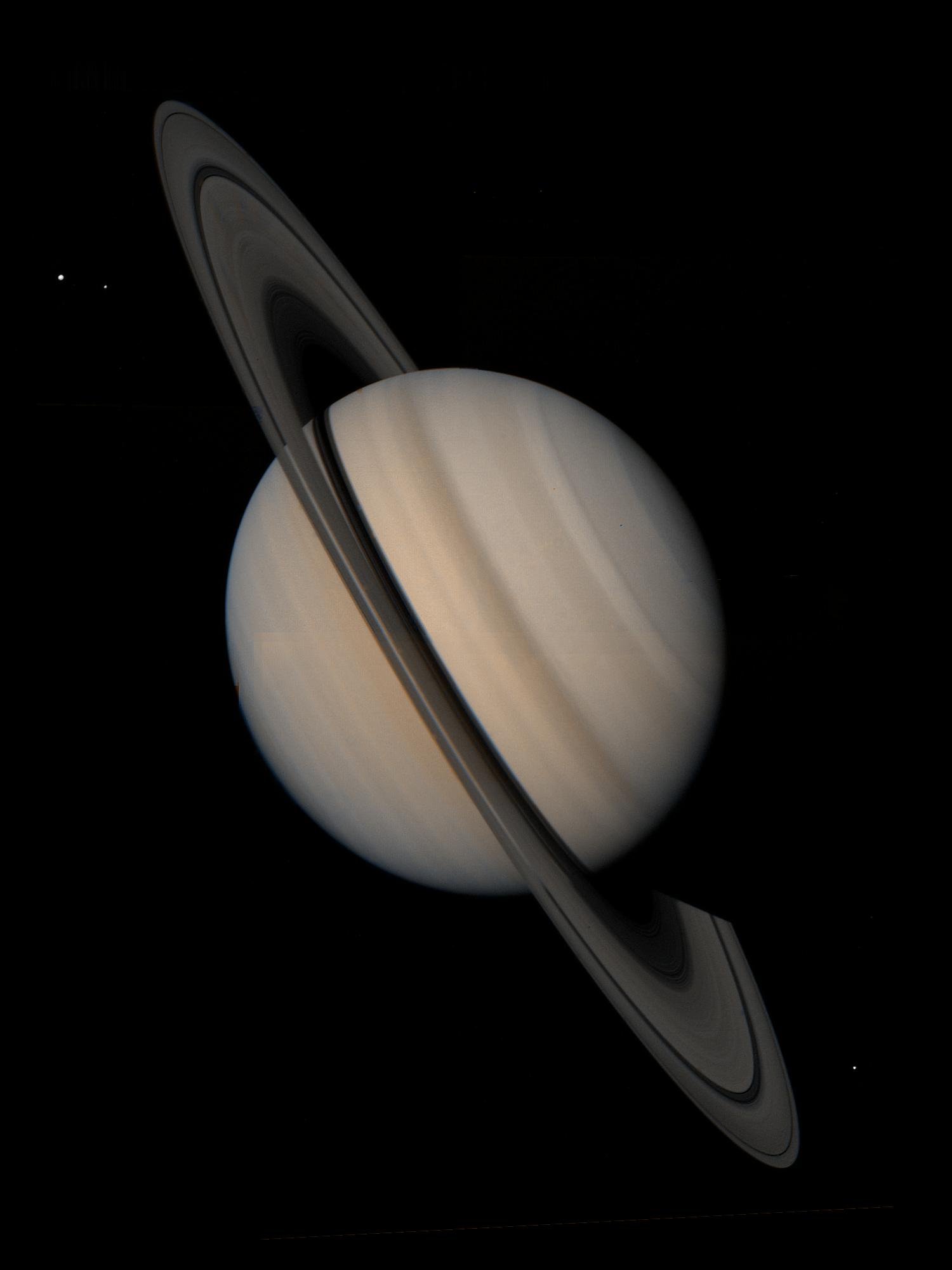
The most distant human-made object

No spacecraft has gone farther than NASA's Voyager 1. Launched in 1977 to fly by Jupiter and Saturn, Voyager 1 crossed into interstellar space in August 2012 and continues to collect data.
Mission Type

What is Voyager 1?
Voyager 1 has been exploring our solar system since 1977. The probe is now in interstellar space, the region outside the heliopause, or the bubble of energetic particles and magnetic fields from the Sun. Voyager 1 was launched after Voyager 2, but because of a faster route it exited the asteroid belt earlier than its twin, and it overtook Voyager 2 on Dec. 15, 1977.
- Voyager 1 discovered a thin ring around Jupiter and two new Jovian moons: Thebe and Metis.
- At Saturn, Voyager 1 found five new moons and a new ring called the G-ring.
- Voyager 1 was the first spacecraft to cross the heliosphere, the boundary where the influences from outside our solar system are stronger than those from our Sun.
- Voyager 1 is the first human-made object to venture into interstellar space.
In Depth: Voyager 1
Voyager 1 at jupiter.
Voyager 1 began its Jovian imaging mission in April 1978 at a range of 165 million miles (265 million km) from the planet. Images sent back by January the following year indicated that Jupiter’s atmosphere was more turbulent than during the Pioneer flybys in 1973–1974.
Beginning on Jan. 30, 1979, Voyager 1 took a picture every 96 seconds for a span of 100 hours to generate a color time-lapse movie to depict 10 rotations of Jupiter. On Feb. 10, the spacecraft crossed into the Jovian moon system and by early March, it had already discovered a thin (less than 19 miles, or 30 kilometers, thick) ring circling Jupiter.
Voyager 1’s closest encounter with Jupiter was at 12:05 UT on March 5, 1979 at a range of about 174,000 miles (280,000 kilometers). It encountered several of Jupiter’s moons, including Amalthea, Io, Europa, Ganymede, and Callisto, returning spectacular photos of their terrain, opening up completely new worlds for planetary scientists.
The most interesting find was on Io, where images showed a bizarre yellow, orange, and brown world with at least eight active volcanoes spewing material into space, making it one of the most (if not the most) geologically active planetary body in the solar system. The presence of active volcanoes suggested that the sulfur and oxygen in Jovian space may be a result of the volcanic plumes from Io, which are rich in sulfur dioxide. The spacecraft also discovered two new moons, Thebe and Metis.
Voyager 1 at Saturn

Following the Jupiter encounter, Voyager 1 completed an initial course correction on April 9, 1979, in preparation for its meeting with Saturn. A second correction on Oct. 10, 1979, ensured that the spacecraft would not hit Saturn’s moon Titan.
Its flyby of the Saturn system in November 1979 was as spectacular as its previous encounter. Voyager 1 found five new moons, a ring system consisting of thousands of bands, wedge-shaped transient clouds of tiny particles in the B ring that scientists called “spokes,” a new ring (the “G-ring”), and “shepherding” satellites on either side of the F-ring—satellites that keep the rings well-defined.
During its flyby, the spacecraft photographed Saturn’s moons Titan, Mimas, Enceladus, Tethys, Dione, and Rhea. Based on incoming data, all the moons appeared to be composed largely of water ice. Perhaps the most interesting target was Titan, which Voyager 1 passed at 05:41 UT on Nov. 12 at a range of 2,500 miles (4,000 kilometers). Images showed a thick atmosphere that completely hid the surface. The spacecraft found that the moon’s atmosphere was composed of 90% nitrogen. Pressure and temperature at the surface was 1.6 atmospheres (1 atmosphere equals the average air pressure at sea level on Earth) and minus 290°F (minus 179°C), respectively.
Atmospheric data suggested that Titan might be the first body in the solar system (apart from Earth) where liquid could exist on the surface. In addition, the presence of nitrogen, methane, and more complex hydrocarbons indicated that prebiotic chemical reactions might be possible on Titan.
Voyager 1’s closest approach to Saturn was at 23:46 UT on Nov. 12, 1980, at a range of 78,000 miles (126,000 kilometers).
Voyager 1’s ‘Family Portrait’ Image
Following the encounter with Saturn, Voyager 1 headed on a trajectory escaping the solar system at a speed of about 3.5 AU per year, 35° out of the ecliptic plane to the north, in the general direction of the Sun’s motion relative to nearby stars. Because of the specific requirements for the Titan flyby, the spacecraft was not directed to Uranus and Neptune.
The final images taken by the Voyagers comprised a mosaic of 64 images taken by Voyager 1 on Feb. 14, 1990, at a distance of 40 AU, of the Sun and all the planets of the solar system (although Mercury and Mars did not appear, the former because it was too close to the Sun and the latter because Mars was on the same side of the Sun as Voyager 1 so only its dark side faced the cameras).
This was the so-called “pale blue dot” image made famous by Cornell University professor and Voyager science team member Carl Sagan (1934-1996). These were the last of a total of 67,000 images taken by the two spacecraft.
Voyager 1’s Interstellar Mission
With all the planetary encounters finally over in 1989, the missions of Voyager 1 and 2 were declared part of the Voyager Interstellar Mission (VIM), which officially began on Jan. 1, 1990.
The goal was to extend NASA’s exploration of the solar system beyond the neighborhood of the outer planets to the outer limits of the Sun’s sphere of influence, and “possibly beyond.” Specific goals include collecting data on the transition between the heliosphere, the region of space dominated by the Sun’s magnetic field and solar field, and the interstellar medium.
On Feb. 17, 1998, Voyager 1 became the most distant human-made object in existence when, at a distance of 69.4 AU from the Sun, it “overtook” Pioneer 10.
On Dec. 16, 2004, Voyager scientists announced that Voyager 1 had reported high values for the intensity for the magnetic field at a distance of 94 AU, indicating that it had reached the termination shock and had now entered the heliosheath.
The spacecraft finally exited the heliosphere and began measuring the interstellar environment on Aug. 25, 2012, the first spacecraft to do so.
On Sept. 5, 2017, NASA marked the 40th anniversary of its launch, as it continues to communicate with NASA’s Deep Space Network and send data back from four still-functioning instruments – the cosmic-ray telescope, the low-energy charged particles experiment, the magnetometer, and the plasma waves experiment.
The Golden Record

Each of the Voyagers contain a “message,” prepared by a team headed by Carl Sagan, in the form of a 12-inch (30-centimeter) diameter gold-plated copper disc for potential extraterrestrials who might find the spacecraft. Like the plaques on Pioneers 10 and 11, the record has inscribed symbols to show the location of Earth relative to several pulsars.
The records also contain instructions to play them using a cartridge and a needle, much like a vinyl record player. The audio on the disc includes greetings in 55 languages, 35 sounds from life on Earth (such as whale songs, laughter, etc.), 90 minutes of generally Western music including everything from Mozart and Bach to Chuck Berry and Blind Willie Johnson. It also includes 115 images of life on Earth and recorded greetings from then-U.S. President Jimmy Carter (1924– ) and then-UN Secretary-General Kurt Waldheim (1918–2007).
By January 2024, Voyager 1 was about 136 AU (15 billion miles, or 20 billion kilometers) from Earth, the farthest object created by humans, and moving at a velocity of about 38,000 mph (17.0 kilometers per second) relative to the Sun.

National Space Science Data Center: Voyager 1
A library of technical details and historic perspective.

Beyond Earth: A Chronicle of Deep Space Exploration
A comprehensive history of missions sent to explore beyond Earth.
Discover More Topics From NASA

Our Solar System

We use cookies and similar technologies on our website to improve performance and make your experience better. Your use of our website indicates your consent to the cookies described in this policy.
The browser you are using is not compatible with Blinklearning Update your browser to a newer version
Voyages neu A1 Kurs- und Übungsbuch
Change theme

Access type:
- Also available without connection
Compatible devices:
- Windows App
How can we help you?
Couldn't find what you were looking for, please describe the issue you are experiencing and provide as many details as possible. let us know the book, class, access device, licence code, username, used browser or if it occcurs in our app:.
- 1 Intro
- 2 Bienvenue !
- 3 Rencontres 2
- 4 En Ville 3
- 5 Savoir-faire 4
- 6 On fait les courses 5
- 7 Bon appétit ! 6
- 8 À la mode 7
- 9 Savoir-faire 8
- 10 En voyage 9
- 11 Ensemble 10
- 12 Les loisirs 11
- 13 Savoir-faire 12
- 14 Bienvenue! 1 (UeB)
- 15 Rencontres 2 (UeB)
- 16 En Ville 3 (UeB)
- 17 Test 4 (UeB)
- 18 On fait les courses 5 (UeB)
- 19 Bon appétit! 6 (UeB)
- 20 À la mode 7 (UeB)
- 21 Test 8 (UeB)
- 22 En voyage 9 (UeB)
- 23 Ensemble 10 (UeB)
- 24 Les loisirs 11 (UeB)
- 25 Test 12 (UeB)
- 26 Anhang
- + Create lesson

- Português BR
- Português PT

- The Contents
- The Making of
- Where Are They Now
- Frequently Asked Questions
- Q & A with Ed Stone
golden record
Where are they now.
- frequently asked questions
- Q&A with Ed Stone
Mission Status
Instrument status.

Where are the Voyagers now?
To learn more about Voyager, zoom in and give the spacecraft a spin. View the full interactive experience at Eyes on the Solar System . Credit: NASA/JPL-Caltech
View Voyager
Space Flight Operations Schedule (SFOS)
SFOS files showing Voyager activity on Deep Space Network (DSN)
Internet Archive Audio

- This Just In
- Grateful Dead
- Old Time Radio
- 78 RPMs and Cylinder Recordings
- Audio Books & Poetry
- Computers, Technology and Science
- Music, Arts & Culture
- News & Public Affairs
- Spirituality & Religion
- Radio News Archive

- Flickr Commons
- Occupy Wall Street Flickr
- NASA Images
- Solar System Collection
- Ames Research Center

- All Software
- Old School Emulation
- MS-DOS Games
- Historical Software
- Classic PC Games
- Software Library
- Kodi Archive and Support File
- Vintage Software
- CD-ROM Software
- CD-ROM Software Library
- Software Sites
- Tucows Software Library
- Shareware CD-ROMs
- Software Capsules Compilation
- CD-ROM Images
- ZX Spectrum
- DOOM Level CD

- Smithsonian Libraries
- FEDLINK (US)
- Lincoln Collection
- American Libraries
- Canadian Libraries
- Universal Library
- Project Gutenberg
- Children's Library
- Biodiversity Heritage Library
- Books by Language
- Additional Collections

- Prelinger Archives
- Democracy Now!
- Occupy Wall Street
- TV NSA Clip Library
- Animation & Cartoons
- Arts & Music
- Computers & Technology
- Cultural & Academic Films
- Ephemeral Films
- Sports Videos
- Videogame Videos
- Youth Media
Search the history of over 866 billion web pages on the Internet.
Mobile Apps
- Wayback Machine (iOS)
- Wayback Machine (Android)
Browser Extensions
Archive-it subscription.
- Explore the Collections
- Build Collections
Save Page Now
Capture a web page as it appears now for use as a trusted citation in the future.
Please enter a valid web address
- Donate Donate icon An illustration of a heart shape
Voyages in English : writing and grammar
Bookreader item preview, share or embed this item, flag this item for.
- Graphic Violence
- Explicit Sexual Content
- Hate Speech
- Misinformation/Disinformation
- Marketing/Phishing/Advertising
- Misleading/Inaccurate/Missing Metadata
![[WorldCat (this item)] [WorldCat (this item)]](https://archive.org/images/worldcat-small.png)

plus-circle Add Review comment Reviews
139 Previews
11 Favorites
DOWNLOAD OPTIONS
No suitable files to display here.
PDF access not available for this item.
IN COLLECTIONS
Uploaded by station59.cebu on April 5, 2021
SIMILAR ITEMS (based on metadata)
NASA's Voyager 1 spacecraft finally phones home after 5 months of no contact
On Saturday, April 5, Voyager 1 finally "phoned home" and updated its NASA operating team about its health.

NASA's interstellar explorer Voyager 1 is finally communicating with ground control in an understandable way again. On Saturday (April 20), Voyager 1 updated ground control about its health status for the first time in 5 months. While the Voyager 1 spacecraft still isn't sending valid science data back to Earth, it is now returning usable information about the health and operating status of its onboard engineering systems.
Thirty-five years after its launch in 1977, Voyager 1 became the first human-made object to leave the solar system and enter interstellar space . It was followed out of our cosmic quarters by its space-faring sibling, Voyager 2 , six years later in 2018. Voyager 2, thankfully, is still operational and communicating well with Earth.
The two spacecraft remain the only human-made objects exploring space beyond the influence of the sun. However, on Nov. 14, 2023, after 11 years of exploring interstellar space and while sitting a staggering 15 billion miles (24 billion kilometers) from Earth, Voyager 1's binary code — computer language composed of 0s and 1s that it uses to communicate with its flight team at NASA — stopped making sense.
Related: We finally know why NASA's Voyager 1 spacecraft stopped communicating — scientists are working on a fix
In March, NASA's Voyager 1 operating team sent a digital "poke" to the spacecraft, prompting its flight data subsystem (FDS) to send a full memory readout back home.
This memory dump revealed to scientists and engineers that the "glitch" is the result of a corrupted code contained on a single chip representing around 3% of the FDS memory. The loss of this code rendered Voyager 1's science and engineering data unusable.

The NASA team can't physically repair or replace this chip, of course, but what they can do is remotely place the affected code elsewhere in the FDS memory. Though no single section of the memory is large enough to hold this code entirely, the team can slice it into sections and store these chunks separately. To do this, they will also have to adjust the relevant storage sections to ensure the addition of this corrupted code won't cause those areas to stop operating individually, or working together as a whole. In addition to this, NASA staff will also have to ensure any references to the corrupted code's location are updated.
Get the Space.com Newsletter
Breaking space news, the latest updates on rocket launches, skywatching events and more!
— Voyager 2: An iconic spacecraft that's still exploring 45 years on
— NASA's interstellar Voyager probes get software updates beamed from 12 billion miles away
— NASA Voyager 2 spacecraft extends its interstellar science mission for 3 more years
On April 18, 2024, the team began sending the code to its new location in the FDS memory. This was a painstaking process, as a radio signal takes 22.5 hours to traverse the distance between Earth and Voyager 1, and it then takes another 22.5 hours to get a signal back from the craft.
By Saturday (April 20), however, the team confirmed their modification had worked. For the first time in five months, the scientists were able to communicate with Voyager 1 and check its health. Over the next few weeks, the team will work on adjusting the rest of the FDS software and aim to recover the regions of the system that are responsible for packaging and returning vital science data from beyond the limits of the solar system.
Join our Space Forums to keep talking space on the latest missions, night sky and more! And if you have a news tip, correction or comment, let us know at: [email protected].
Robert Lea is a science journalist in the U.K. whose articles have been published in Physics World, New Scientist, Astronomy Magazine, All About Space, Newsweek and ZME Science. He also writes about science communication for Elsevier and the European Journal of Physics. Rob holds a bachelor of science degree in physics and astronomy from the U.K.’s Open University. Follow him on Twitter @sciencef1rst.
Boeing Starliner 1st astronaut flight: Live updates
SpaceX to launch 2nd batch of next-gen US spy satellites tonight
NASA delays next ISS spacewalk until end of July due to spacesuit leak issue
- Robb62 'V'ger must contact the creator. Reply
- Holy HannaH! Couldn't help but think that "repair" sounded extremely similar to the mechanics of DNA and the evolution of life. Reply
- Torbjorn Larsson *Applause* indeed, thanks to the Voyager teams for the hard work! Reply
- SpaceSpinner I notice that the article says that it has been in space for 35 years. Either I have gone back in time 10 years, or their AI is off by 10 years. V-*ger has been captured! Reply
Admin said: On Saturday, April 5, Voyager 1 finally "phoned home" and updated its NASA operating team about its health. The interstellar explorer is back in touch after five months of sending back nonsense data. NASA's Voyager 1 spacecraft finally phones home after 5 months of no contact : Read more
evw said: I'm incredibly grateful for the persistence and dedication of the Voyagers' teams and for the amazing accomplishments that have kept these two spacecrafts operational so many years beyond their expected lifetimes. V-1 was launched when I was 25 years young; I was nearly delirious with joy. Exploring the physical universe captivated my attention while I was in elementary school and has kept me mesmerized since. I'm very emotional writing this note, thinking about what amounts to a miracle of technology and longevity in my eyes. BRAVO!!! THANK YOU EVERYONE PAST & PRESENT!!!
- EBairead I presume it's Fortran. Well done all. Reply
SpaceSpinner said: I notice that the article says that it has been in space for 35 years. Either I have gone back in time 10 years, or their AI is off by 10 years. V-*ger has been captured!
EBairead said: I presume it's Fortran. Well done all.
- View All 13 Comments
Most Popular
- 2 Watch India's reusable space plane prototype ace its final landing test (video)
- 3 Perseverance Mars rover team revives life-hunting instrument after 6 months of effort
- 4 International Space Station: Live updates
- 5 Boeing Starliner 1st astronaut flight: Live updates

Chocolate organiko

la-mere-poulard

- Spices & Seasonings
- Additional Categories
HOT CHOCOLATE BOMBS (2.20 oz.)
- Confectionary
- Cookies & Crackers
- Spices & Seasoning
- Charcuterie
- Honey Preserve & Fruit Spreads
- Oils & Vinegars
© 2023 Voyage-Marche, Inc. All rights reserved.
- Fachberatung |
- Veranstaltungen |
- International |
Klett-Sprachen Anmeldung
Meine persönlichen Daten
Meine Bildungseinrichtungen und Fächer
Meine Online-Bestellungen
Meine Newsletter
- Englisch
- Französisch
- Spanisch
- Italienisch
- Deutsch als Fremdsprache
- Deutsch als Zweitsprache
- Deutsch
- Weitere Sprachen

- Englisch für den Beruf

- Digitale Ausgaben
- Einstufungstests
- Hybride Ausgaben für allango
- Online-Übungen
- Media Bundles für BlinkLearning
- Service und Extras

- Deutsch als Fremdsprache
- Englisch für den Beruf
- Italienisch
Französisch
- Weitere Sprachen

Lernvokabelheft
ISBN 978-3-12-529218-5
Produkt vergriffen
Tel.: 0711 / 66 72 15 55

- Hilfe & Kundenservice
- Fachberatung
- Klett Treffpunkte
- Rights and Permissions
- Zahlung & Versandkosten
- Newsletter
- Kataloge
- Klett Tipps
- Presse
- Wir über uns
- Nachhaltigkeit
- Karriere
- AGB und Widerruf
- Datenschutz und Cookies
- Cookie-Einstellungen ändern
- Impressum
© Ernst Klett Sprachen GmbH 2024. Alle Rechte vorbehalten
Switch to international Internet presence Wechsel zur spanischen Internetpräsenz
If you teach or study outside Germany, Switzerland, Austria or Liechtenstein, we are delighted to welcome you to our international website. This new multilingual platform offers you a comprehensive range of products and services available worldwide.
Wenn Sie in Spanien unterrichten oder lernen, freuen wir uns, Sie auf unserer spanischen Webseite begrüßen zu dürfen.
Special Features
Vendor voice.
Voyager 1 makes stellar comeback to science operations
Engineers coax veteran probe back to health.
NASA's Voyager 1 spacecraft is back in action and conducting normal science operations for the first time since the veteran probe began spouting gibberish at the end of 2023.
All four of the spacecraft's remaining operational instruments are now returning usable data to Earth, according to NASA .
Some additional work is needed to tidy up the effects of the issue. Engineers need to resynchronize the timekeeping software of Voyager 1's three onboard computers to ensure that commands are executed at the correct times. Maintenance will also be performed on the digital tape recorder, which records some data from the plasma instrument for a six-monthly downlink to Earth.
As the 50th anniversary of Voyager 1's launch rapidly approaches, and with the probe now 15 billion miles (24 billion kilometers) from Earth, restoring functionality is quite an engineering feat.
Voyager 1's woes began in November 2023, when the spacecraft stopped transmitting usable data back to Earth. Rather than engineering and science data, NASA found itself faced with a repeating pattern of ones and zeroes, as though the spacecraft was somehow stalled.
Engineers reckoned the issue lay with the Flight Data System (FDS) and in March sent a command – dubbed a "poke" – to get the FDS to try some other software sequences and thus circumvent whatever was causing the problem.
The result was a complete memory dump from the computer, which allowed engineers to pinpoint where the corruption had occurred. It appeared that a single chip was malfunctioning, and engineers were faced with the challenge of devising a software update that would work around the defective hardware.
Dr Ed Stone, former director of JPL, Voyager project scientist, dies at 88
- Voyager 1 regains sanity after engineers patch around problematic memory
- NASA tries to jog Voyager 1's memory from 15 billion miles away
- Voyager 1 starts making sense again after months of babble
Usable engineering data began to be returned later in April, and in May the mission team sent commands to instruct the probe to keep science data flowing. The result was that the plasma wave subsystem and magnetometer instrument began sending data immediately. According to NASA, the cosmic ray subsystem and low energy charged particle instrument required a little more tweaking but are now operational.
The rescue was made all the more impressive by the fact that it takes 22.5 hours for a command to reach Voyager 1 and another 22.5 hours for a response to be received on Earth.
How much longer the Voyagers can continue to function is open to conjecture. The power supplies are gradually degrading, and engineers have been turning off non-essential systems to eke out dwindling resources for as long as possible.
Due the engineers' efforts, there is a very good chance that one or both Voyagers will continue to be operational by the time the 50th anniversary of the mission's launch rolls around in 2027.
A fitting tribute to those who designed the spacecraft, and the mission's first project scientist, Ed Stone, who died recently at the age of 88. ®
Narrower topics
- Climate Change
- Contact Tracing
- Fusion Power
- Hubble Space Telescope
- James Webb Space Telescope
- Meteorology
- Neil Gehrels Swift Observatory
- Perseverance
- Solar System
- Square Kilometre Array
- Superconductor
Broader topics
- Federal government of the United States
Send us news
Other stories you might like
Nasa ought to pay up after space debris punched a hole in my roof, homeowner says, nasa finds humanity would totally fumble asteroid defense, elon musk to destroy the international space station – with nasa's approval, for a fee, are our it decisions costing the planet.
Perseverance pays off as Mars rover's SHERLOC brought back from the brink
Humanity's satellite habit could end up choking earth's ozone layer, nasa hits wrong button, broadcasts iss emergency training by mistake, iss 'nauts told to duck and cover after dead russian sat sprays space junk, nasa tests the ups and downs of air taxi comfort with vr, starliner to remain docked to the iss into july – with no new departure date, india to build re-usable launch vehicle after nailing third landing of mini-spaceplane.
- Advertise with us
Our Websites
- The Next Platform
- Blocks and Files
Your Privacy
- Cookies Policy
- Privacy Policy
- Ts & Cs

Copyright. All rights reserved © 1998–2024

IMAGES
VIDEO
COMMENTS
Lehr- und Arbeitsbuch + 2 Audio-CDs. 240 Seiten. ISBN 978-3-12-529276-5. Produkt vergriffen. Zum Inhalt. Voyages wendet sich an erwachsene Anfänger und deckt in 3 Bänden die Niveaustufen A1, A2 und B1 des Gemeinsamen europäischen Referenzrahmens ab. Die 12 Lektionen des Lehr- und Arbeitsbuches für ca. 80-90 Unterrichtsstunden vermitteln das ...
Kurs- und Übungsbuch mit Audios. 248 Seiten. ISBN 978-3-12-529412-7. lieferbar. Erhältlich als: Hybride Ausgabe allango. 34,99 EUR Printausgabe. 31,50 EUR Digitale Ausgabe allango. für Unterrichtende und Lernende.
Voyages, das erfolgreiche 3-bändige Anfängerlehrwerk für Erwachsene, die mit Schwung und Erfolg Französisch lernen möchten, erscheint als neue Ausgabe.. Voyages neu - mehr als eine Reise. Voyages neu garantiert einen sanften Einstieg. neue Einstiegslektion; kürzere Texte und weniger Wortschatz; Voyages neu verbindet Bewährtes mit Neuem. bewährter Mix aus Dialogen, inspirierenden ...
Verlagsinformation klett: Voyages neu - mehr als eine Reise! Voyages neu garantiert einen sanften Einstieg neue Einstiegslektion. Bibliographic information. Title: Voyages neu A1: Kurs- und Übungsbuch + 2 Audio-CDs Voyages - Neue Ausgabe: Authors:
Klett Sprachen, 2013. Other editions - View all. Voyages - Neue Ausgabe. Vokabelheft + CD/MP3 + CD-ROM (PC/Mac) Krystelle Jambon, Myriam Goupille, Jacqueline Sword, Anne Guilaine Andr ... Voyages - Neue Ausgabe: Publisher: Klett Sprachen, 2013: ISBN: 3125294185, 9783125294189 : Export Citation:
vocabulaire 1 Learn with flashcards, games, and more — for free. Search. Create. Log in Sign up. Log in Sign up. 186 terms. tootsi71. Klett Voyages 1, Unité 1. vocabulaire 1. STUDY. PLAY. Bienvenue! Herzlich Willkommen! la France.
Dans cette vidéo, tous les fichiers audio de Voyages 1, chapitre 1 sont regroupés en une seule vidéo. Le texte français apparaît à gauche et le texte alleman...
Study with Quizlet and memorize flashcards containing terms like le savoir-faire, apprendre, le vocabulaire and more.
Voyager 1 has been exploring our solar system since 1977. The probe is now in interstellar space, the region outside the heliopause, or the bubble of energetic particles and magnetic fields from the Sun. Voyager 1 was launched after Voyager 2, but because of a faster route it exited the asteroid belt earlier than its twin, and it overtook Voyager 2 on Dec. 15, 1977.
Start studying Voyages 1 Klett Unité 9. Learn vocabulary, terms, and more with flashcards, games, and other study tools.
Voyages und Voyayes neu: Lehrwerke, Lektüren, Wortschatz-Material oder Downloads: Auf klett-sprachen.de finden Sie alles für den Sprachunterricht.
Voyages neu A1 Kurs- und Übungsbuch Change theme. Automatic. Light mode. Dark mode. Voyages neu A1 Kurs- und Übungsbuch. Ernst Klett Sprachen FLE (French Foreign Language) ISBN: NP00852941201. Access type: Also available without connection Compatible devices: PC; iPad; Android; Windows App ...
Note: Because Earth moves around the sun faster than Voyager 1 is speeding away from the inner solar system, the distance between Earth and the spacecraft actually decreases at certain times of year. Distance from Sun: This is a real-time indicator of Voyagers' straight-line distance from the sun in astronomical units (AU) and either miles (mi ...
Voyager 1 is a space probe launched by NASA on September 5, 1977, as part of the Voyager program to study the outer Solar System and the interstellar space beyond the Sun's heliosphere. It was launched 16 days after its twin, Voyager 2.
Check out the new look and enjoy easier access to your favorite features
sagen Sie. Click the card to flip 👆
Kurs- und Übungsbuch mit Audios. inkl. MwSt., zzgl. Versand. Der dritte Band von Voyages neu führt zu Niveau B1 des Gemeinsamen Europäischen Referenzrahmens. Er eignet sich auch für Quereinsteiger und leichte Konversationskurse. Gut wie immer: Der übersichtliche Lektionsaufbau garantiert eine leichte Orientierung.
Voyages in English : writing and grammar. Publication date 2006 ... 1.0000 Ocr_module_version 0.0.13 Ocr_parameters-l eng Old_pallet IA-NS-1300177 Openlibrary_edition OL11464090M Openlibrary_work OL24424527W Page_number_confidence 97.01 Pages 570 Pdf_module_version ...
On Saturday, April 5, Voyager 1 finally "phoned home" and updated its NASA operating team about its health. The interstellar explorer is back in touch after five months of sending back nonsense data.
1 a. Le camembert : 2, 35 € Le paquet de biscuits : 4,20 € La bouteille d'eau minérale : 0,54 € La bouteille d'huile : 3,90 € La boîte de 6 œufs : 1,80 €. 2 a. Flasche - bouteille Dose / Schachtel - boîte Päckchen - paquet Scheibe - tranche Stück - morceau Becher / Glas - pot. 2 b.
Klett Voyages 1 - Unité 3. VHS-Dortmund Französisch 01/14 - 06/14. STUDY. PLAY. en ville. in der Stadt. la Place des Vosges. Platz der Vogesen (die) Platz in Paris. la place. Platz (die) la station de métro.
© 2023 Voyage-Marche, Inc. All rights reserved. Search. Search
Lernvokabelheft. 56 Seiten. ISBN 978-3-12-529218-5. Produkt vergriffen. Zum Inhalt. Das Lernvokabelheft umfasst den thematischen Lernwortschatz aus Voyages 1, mit dessen Hilfe sich die Lernenden die wichtigsten Vokabeln jeder Lektion leicht einprägen können. Außerdem enthält es wertvolle Tipps zum Vokabellernen sowie ein deutsch ...
The rescue was made all the more impressive by the fact that it takes 22.5 hours for a command to reach Voyager 1 and another 22.5 hours for a response to be received on Earth. How much longer the Voyagers can continue to function is open to conjecture. The power supplies are gradually degrading, and engineers have been turning off non ...
Vocabulary Unit 1 Klett. 0 study sets, 1 member. Word voyage unit 1. Barkai Yeshiva · New York, NY. 0 study sets, 2 members. Voyages 1 unité 5 DHA. Bsd Bern · Berne, Switzerland. 1 study set, 1 member. Voyages A1 - unité 0, 1, 1a.